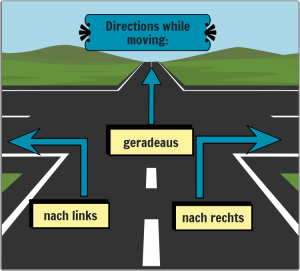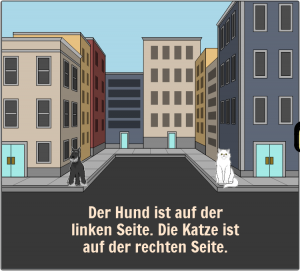15 Wiederholung: Imperative & Giving Directions
WIEDERHOLUNG: Giving and following directions.
Every year, students seem to forget the imperative, aka commands, so here’s a brief review to connect it with giving and following directions.
Summary of the Imperative Mood:
|
|
du |
Sie |
ihr |
Let’s _____. |
|
How to make the command: |
verb stem; keep stem-change of e to i(e) verbs. |
infinitive + Sie |
verb conjugated for “ihr” |
infinitive + wir |
|
Example with verbs warten and sprechen: |
Wart’!/Warte! Sprich! |
Warten Sie! Sprechen Sie! |
Wartet! Sprecht! |
Warten wir! Sprechen wir! |
|
Watch out! |
Don’t include “du” with the command. |
Include “Sie” with the command. |
Don’t include “ihr” with the command. |
Include “wir” with the command. |
|
Irregular verb sein |
Sei! |
Seien Sie! |
Seid! (not irregular) |
Seien wir! |
Listen to Annukka from AudioLingua describing her bike route to school. You will hear several of the directional words in the box.

Video. Watch Easy German’s video about giving directions.


When asking for directions, you can phrase these questions using German that you already know.
- Ich suche die Apotheke. I’m looking for the pharmacy.
- Gibt es hier einen Supermarkt? Is there a supermarket here?
Don’t forget that the direct object will go in the accusative case, i.e. masculine gets an extra -en.
To give directions, use the imperative.
- Gehen Sie geradeaus. Go straight ahead.
- Fahren Sie nach links. Drive to the left.
- Laufen Sie in diese Richtung. Run/walk in this direction.
If you know the person well, you can use an informal du-command.
- Geh geradeaus.
- Fahr nach links.
- Lauf in diese Richtung.
If you want to suggest to your group of friends to go in a certain direction, you can always use the wir-command form.
- Gehen wir geradeaus. Let’s go straight ahead.
- Fahren wir nach links. Let’s drive to the left.
- Laufen wir in diese Richtung. Let’s run/walk in this direction.
If you want to tell someone to go past something, use the following construction with an…vorbei, “past.”
- Gehen Sie an „Moes“ vorbei. Go past „Moes.“
Ex. A: Wir fragen nach der Richtung. Using the destinations on the same floor as your classroom, give directions on how to get there.
Beispiel: die Toilette
A: Gibt es hier eine Toilette?/Ich suche die Toilette.
B: Ja, die Toilette ist nah. Gehen Sie geradeaus. Dann gehen Sie nach links. Die Toilette ist auf der linken Seite.
- das Fremdsprachenbüro
- Zimmer 106
- die Damentoilette
- die Herrentoilette
- das Forschungsbüro
- das Büro Ihrer (of your) Professorin
- die Haupttür
- die Hintertür

Ex. B: Meine 4-Zimmer-Wohnung. Listen to Katrin (AudioLingua) describing her apartment as if you were walking through it. You will hear several directional phrases. Draw a diagram of the apartment based on what you hear.
Now listen to Ulrich (AudioLingua) describing his Ferienwohnung. Using the directional phrases from this section, draw a diagram of his vacation house.
Ex. C: Ein kleines Theatherstück. Go back to Section 9-2 to review the verbs with prepositional complements. Then create a short skit using these verb with commands. Act it out in front of your class with all the drama of a cheesy soap opera.
Prompt: One of your friends (or coworkers) has a problem. Tell him how to solve his problem with the imperative, but use the verbs with prepositions from 9-2. A sample beginning might go as follows.
Brandon: Ich habe nicht genug Geld.
Freund 1: Bewirb dich um einen Job bei der Bibliothek.
Freund 2: Bitte deine Eltern um mehr Geld.
Freund 3: Tja. Du hast nicht genug Geld. Gewöhn dich daran.

